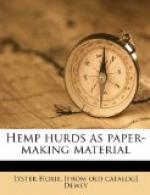The first test consisted in making four separate cooks, Nos. 293, 294, 295, and 296, of approximately 300 pounds each, dividing the total stock into two parts and making two separate paper tests. The first test was made primarily in order to learn some of the qualities and characteristics of the stock and to get the machinery equipment adjusted properly. The yield of fiber was not determined in this preliminary test, since the knowledge of it was not essential at this stage of the work. The cooked stock which was emptied into the drainer to be washed free from black liquor was composed largely of whole pieces of hurds, but only slight pressure between the fingers was required to crush the pieces. In the case of wood, this condition ordinarily would indicate undercooking, but might not in the case of hurds. Further observation on the action of the cooked stock during subsequent processes was necessary in order to judge of its quality or the suitability of the cooking conditions. The total cooked stock, about 500 pounds, was divided into two portions of 200 and 300 pounds, respectively, and work was continued on them separately. The 200-pound test, designated as run No. 135, was put into a 350-pound washing engine, washed one hour, and given a total light brush of 2-1/4 hours. The washing removed a great amount of dirt, but the engine did not reduce the hurd stock as much as was desired. After heating the stock in the beater to 40 deg. C., it was bleached with bleaching-powder solution, 94 gallons at 0.418 pound bleach per gallon, equivalent to 19.7 per cent of the fiber. This percentage of bleach is regarded as too high for stock intended for book-paper manufacture, and subsequent cooks therefore were given harder treatment in order to reduce this figure. After draining and washing free from bleach residues, the stock was furnished in the beater with 13 per cent of clay, 1 per cent of resin size, and 2.5 per cent of alum, was tinted blue, given one hour’s light brush, and pumped to the stock chest. When running it on the paper machine, the Jordan refiner seemed to have little effect in reducing shives of undertreated wood, which indicated further the necessity of harder cooking. The furnish acted well on the paper machine at 70 feet per minute, but appeared somewhat too “free” on the wire. The paper produced from this test is of very low quality, due to the improper preparation of the stock, lack of sufficient bleach, the use of too small an amount of blue tinting, and the presence of an excessive amount of dirt, sand, and shives. The excessive amount of dirt and sand suggested the sieving of the hurds before cooking, and this was performed in all subsequent cooks.
The finish of the sheet is very poor, due to the fact that the calender stack was composed of very light rolls which did not have a satisfactory surface, yet the stack is known to be able to produce better finishes if the proper stock is employed.




